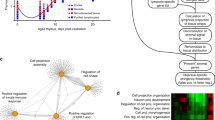Abstract
THE normal thymus consists of two basic components: a reticular–epithelial component derived from the third and fourth bronchial pouches1 and a lymphoid component from stem cells which migrate into the embryonal thymus from fetal liver2 and later from bone marrow3. Two types of thymic reticular cells have been observed by electron microscopy: epithelial reticular cells and mesenchymal reticular cells or macrophages. The villous epithelial cells of the cortex and the cystic epithelial cells of the medulla were shown to be important for T cell differentiation4. Cultures of thymus epithelial cells were shown to induce the differentiation of precursor cells into certain mature T lymphocytes5,6. Recent studies have suggested that thymic epithelium cells (derived from leukaemic thymus) were capable of providing the leukaemogenic signal and thereby inducing in vitro leukaemia transformation of normal thymocytes. Thus, it was claimed that young AKR thymocytes cultured on thymus epithelium monolayers from aged AKR mice could induce leukaemia when injected into normal young recipients7. Similarly, monolayers of thymus epithelium cells, derived from radiation leukaemia virus-induced thymomas in C57BL/6 mice could bring about transformation of normal C57BL/6 thymocytes, thereby demonstrating in vitro leukaemogenesis8. Our aim here was to study further the possible role of the thymic epithelial reticulum (TER) in leukaemogenesis and we present evidence that the leukaemic cells are not derived from the thymus lymphocytes, nor from a ‘transformation capacity’ of the epithelial cells themselves, but that they are already present within phagocytic TER cells. We used the thymic epithelium monolayer–thymocyte co-cultivation method7,8 and the transplantation bioassay genotype analysis method9 (used to demonstrate the origin of the developing leukaemias following injection of thymocytes or thymic epithelium cells into appropriate recipients).
This is a preview of subscription content, access via your institution
Access options
Subscribe to this journal
Receive 51 print issues and online access
$199.00 per year
only $3.90 per issue
Buy this article
- Purchase on Springer Link
- Instant access to full article PDF
Prices may be subject to local taxes which are calculated during checkout
Similar content being viewed by others
References
Metcalf, D. Recent Results in Cancer Research Vol. 5 (Springer, Heidelberg, 1966).
Owen, J. J. T. & Raff, M. C. J. exp. Med. 132, 1216–1232 (1970).
Ford, C. E. & Micklem, H. S. Lancet i, 359 (1963).
Mandel, T., Russel, P. J. & Byrd, W. in Proc. 3rd Lepetit Colloquium (ed. Silvestri, L. G.) 183–191 (North-Holland, Amsterdam, 1972).
Waksal, S. D., Cohen, I. R., Waksal, H. W. & St. Pierre, R. L. Fedn Proc. 33, 736 (1974).
Sato, V. L., Waksal, S. D. & Herzenberg, L. A. Cell. Immun. 24, 173–185 (1976).
Waksal, S. D., Smolinsky, S., Cohen, I. R. & Feldman, M. Nature 263, 512–514 (1976).
Haas, M., Sher, T. & Smolinsky, S. Cancer Res. 37, 1800–1807 (1977).
Haran-Ghera, N. in Biology of Radiation Carcinogenesis (eds Yuhas, J. M., Tennant, R. W. & Regan, J. P.) 245 (Raven, New York, 1976).
Haran-Ghera, N. Int. J. Cancer 1, 81–87 (1966).
Haran-Ghera, N., Ben-Yaakov, M. & Peled, A. J. Immun. 116, 600–606 (1977).
Wekerle, H., Cohen, I. R. & Feldman, M. Eur. J. Immun. 3, 745–748 (1973).
Trowell, O. S. Int. J. Radiat. Biol. 4, 163–173 (1961).
Haran-Ghera, N. Leuk. Res. (in the press).
Decleve, A., Sato, C., Lieberman, M. & Kaplan, H. S. Proc. natn. Acad. Sci. U.S.A. 71, 3124–3128 (1974).
Haas, M. J. natn. Cancer Inst. 58, 251–257 (1977).
Haran-Ghera, N. & Peled, A. Br. J. Cancer 19, 730–749 (1967).
Ihle, J. N., Joseph, D. R. & Pazmino, N. H. J. exp. Med. 144, 1406–1423 (1976).
Ginsburg, H. & Sachs, L. J. natn. Cancer Inst. 27, 1153–1171 (1961).
Clark, S. L. Am. J. Anat. 112, 1–33 (1963).
Metcalf, D., Ishidata, M. & Brumby, M. J. natn. Cancer Inst. 38, 527–539 (1967).
Feldman, D. G. & Gross, L. Cancer Res. 26, 412–426 (1966).
Izard, J. & de Harven, E. Cancer Res. 28, 421–433 (1968).
Ioachim, H. & Furth, J. J. natn. Cancer Inst. 32, 339–359 (1964).
Author information
Authors and Affiliations
Rights and permissions
About this article
Cite this article
PELED, A., HARAN-GHERA, N. Lack of transformation of murine thymocytes by thymic epithelium. Nature 274, 266–269 (1978). https://doi.org/10.1038/274266a0
Received:
Accepted:
Published:
Issue Date:
DOI: https://doi.org/10.1038/274266a0
Comments
By submitting a comment you agree to abide by our Terms and Community Guidelines. If you find something abusive or that does not comply with our terms or guidelines please flag it as inappropriate.



